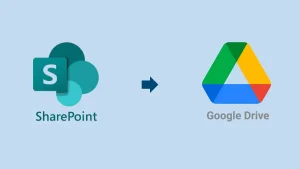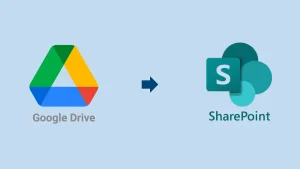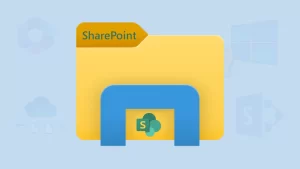Microsoft SharePoint is a cornerstone of digital collaboration, powering content management and internal communication across enterprises. Its security capabilities and ongoing updates make it robust—but like any enterprise platform, there are also SharePoint limitations. This blog explores the core limitations of SharePoint in Microsoft 365 and how professional tools for SharePoint help you overcome those roadblocks.
Understanding the SharePoint Limitations
When organizations adopt SharePoint Online in Microsoft 365, it often feels like the digital equivalent of owning a mansion. There’s room for collaboration, data sharing, and document management—and it all lives in the cloud. Even the largest homes have walls, and SharePoint is no exception.
Let’s walk through the practical limitations of SharePoint that can silently impact your productivity, performance, and planning—especially if you’re managing large teams, complex structures, or mountains of content.
1. Plan-Based SharePoint Storage Limits
Depending on your Microsoft 365 subscription, your SharePoint environment will inherit different thresholds. Here’s a simplified overview but these figures are subject to change:
| Plan | Maximum Users | Storage per Org | Sites per Org | Storage per Site |
|---|---|---|---|---|
| Microsoft 365 Business Plans | 300 | 25TB | 2 Million | 1 TB + 10 GB / User |
| Microsoft 365 E1–E5, SharePoint Plans | 500,000+ | 25 TB | 2 Million | 1TB + 10 GB / User |
| Microsoft 365 F1–F3 | 500,000+ | 25 TB | 2 Million | 1 TB + 10 GB / User |
These base numbers are your operational sandbox. As your usage scales, knowing how far you can go helps you stay in control.
2. Universal SharePoint Service Limits:
Regardless of your plan, certain technical boundaries apply:
Document Library Limit:
- Up to 30 million files, but views with more than 5,000 items may get throttled.
Maximum File Upload Size:
- 250 GB per file.
Maximum Files in Folder for Sharing: –
- 50,000 items.
Versioning: –
- Up to 50,000 major and 511 minor versions per document.
Groups & Permissions: –
- 10,000 groups per site collection
- 5,000 users per group
- 2 million users per site collection
Managed Metadata: –
- 1 million terms
- 2 million term labels
- 1,000 global term groups
Subsites:
- Maximum 2,000 per site collection
Hosted Applications:
- Up to 20,000 instances per tenant
Path Lengths & Naming: –
- 400-character path limit (site URL + folders + file name)
- Avoid characters like ~ ” # % & *: < >? / \ { | }
3. SharePoint Storage Strategy: Pooled & Per Site
Each Microsoft 365 tenant gets pooled SharePoint storage of:
- 10 GB + 0.5 GB per licensed user. This shared pool can be allocated across individual sites (formerly site collections).
- Each site can grow up to 25 TB, but it’s essential to monitor site-specific storage from the SharePoint Admin Center.
Quick Check:
- Navigate to Microsoft 365 Admin Center > SharePoint Admin Center > Active Sites
- View storage used vs. allocated and adjust as needed
4. Sync, Move & Upload Constraints
Moving / Copying Files:
- Up to 30,000 files at once, each under 15 GB, with a 100 GB total size cap
Syncing Limits:
- Up to 300,000 files per library/folder
- Performance degrades significantly over 100,000 items
Upload Timeouts:
- Large files on slower networks of browser-based uploads may fail
OneDrive & Teams Sync Issues:
- Stay under 400 characters in path length to avoid sync errors
Why is it essential to understand the SharePoint limitations?
Being familiar with SharePoint limitations is crucial when transferring data from platforms such as Google Drive or traditional file servers to OneDrive for Business or SharePoint. If your data exceeds these SharePoint limitations, you may encounter delays, performance issues, or even failed migrations. Understanding these boundaries in advance helps you plan effectively and avoid disruptions during the migration process.
Avoid hitting SharePoint limits by using a strategic design from the start:
- Structure libraries with metadata, not deep folders
- Index lists and use filtered views
- Plan storage with lifecycle policies
- Use PowerShell and reports to monitor size, usage, and growth
- Avoid special characters & long names
Final Words:
Migrating to SharePoint without a clear understanding of SharePoint limitations can lead to significant setbacks. It’s essential to review these constraints carefully before beginning your limitation plan. Tools like the Shoviv SharePoint Migration can help assess your data in advance, ensuring it aligns with platform requirements. This proactive step can help prevent unexpected issues and make the transition much smoother.
Frequently Asked Questions:
Yes, additional storage is available for purchase via the Microsoft 365 Admin Center.
You may get throttling errors or performance slowdowns. Use filtered and indexed views to avoid this.
It does, but deep nesting can break sync or exceed the 400-character path limit. Prefer metadata tagging instead.
Keep file names short, avoid emoji and special characters, and ensure total path length stays under 400 characters.
- SharePoint Limitations: File Size & Site Storage Quota - June 17, 2025
- How to Backup Computer to Google Drive (Cloud)? - June 9, 2025
- SharePoint Limited Access Meaning & How does it Works? - June 5, 2025


